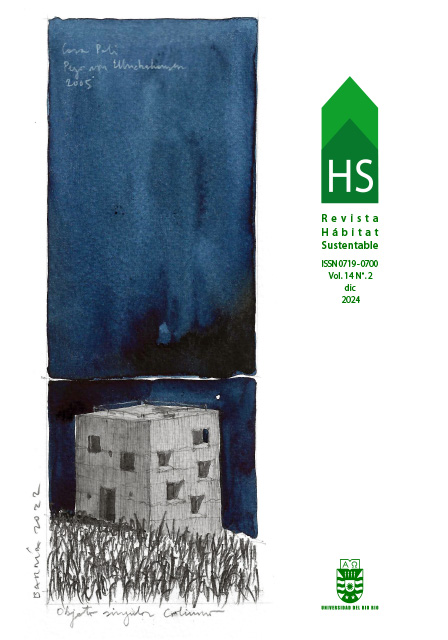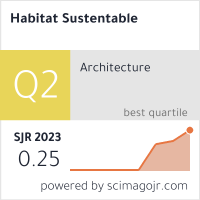Análisis de morfologías evolutivas con CFD: mejorar la ventilación natural en vivienda de patio central, en zonas semi cálidas de Latinoamérica
DOI:
https://doi.org/10.22320/07190700.2024.14.02.04Palabras clave:
diseño evolutivo, ventilación natural, arquitectura sustentable, CFD en vivienda de patio centralResumen
Este estudio busca reducir la demanda energética en la arquitectura mediante el uso de estrategias pasivas, específicamente enfocadas en la ventilación natural interior. Se realizaron simulaciónes computacional (CFD: Computational Fluid Dynamics) y se utilizó algoritmos paramétricos en Grasshopper, en que se aplicó una metodología basada en el diseño evolutivo. El objetivo es optimizar el diseño de viviendas unifamiliares de patio central con ventilación cruzada, al evaluar cómo la morfología de las viviendas influye en su desempeño en términos de ventilación natural. A través de procesos de morfogénesis y diseño evolutivo; se generaron más de 200 variaciones morfológicas (muestras), cuyos resultados permitieron seleccionar los modelos con mejor desempeño. Los genes más exitosos se combinaron en nuevas generaciones para repetir las evaluaciones, lográndose finalmente un modelo de vivienda que optimiza la ventilación hasta 2.5 veces más que el modelo tradicional de casa con patio central.
Descargas
Citas
ALLEN, O. H. (2009). Fitness and its role in evolutionary genetics. Nature Reviews Genetics,10, 531-539. https://doi.org/10.1038/nrg2603
ASCE. (2023a). Appendix D: Effective Strategies to Reduce Dynamic Wind-Induced Response in ASCE, Prestandard for Performance-Based Wind Design (V1.1, pp. 107-108). American Society of Civil Engineers. https://doi.org/10.1061/9780784482186
ASCE. (2023b). Chapter 6: Modeling and Analysis. in ASCE, Prestandard for Performance-Based Wind Design (V1.1, pp. 34-45). American Society of Civil Engineers. https://doi.org/10.1061/9780784482186
ASCE. (2023c). Chapter 5.2.2: Site-Specific Hazard Analysis in ASCE, Prestandard for Performance-Based Wind Design. (V1.1, pp. 23-25). American Society of Civil Engineers. https://doi.org/10.1061/9780784482186
ASCE. (2023d). Chapter 5.3: Wind tunnel test methodologies in ASCE, Prestandard for Performance-Based Wind Design (pp. 25-30). American Society of Civil Engineers. https://doi.org/10.1061/9780784482186
ASHRAE. (2009). INDOOR ENVIRONMENTAL QUALITY, Chapter 13: Indoor Environmental Modeling (TC 4.10, Indoor Environmental Modeling) in ASHRAE, Handook: Fundaments. American Society of Heating, Refrigerating and Air-Conditioning Engineers. https://www.ashrae.org/technical-resources/technical-committees/complete-list-of-tcs-with-home-pages
BANZHAF, W. (2013). Chapter 17: Evolutionary Computation and Genetic Programming in A. Lakhtakia, & R. J. Martín Palma (Eds), Engineered Biomimecry (pp. 430-447). Oxford: Elsevier. https://doi.org/10.1016/B978-0-12-415995-2.00017-9
BENSALEM, R. (1996). Wind-Driven Natural Ventilation in Courtyard and Atrium Type Buildings [Thesis Doctor, School of Architectural Studies. University of Sheffield]. https://etheses.whiterose.ac.uk/3000/1/DX197102.pdf
ECHEVERRI MONTES, P. (27 septiembre de 2021). Grasshopper para Rhino: ¿qué es y cómo se utiliza? Echeverrimontes. https://www.echeverrimontes.com/blog/grasshopper-para-rhino-que-es-y-como-se-utiliza
EL AHMAR, S., BATTISTA, F., y FIORAVANTI, A. (2019). Simulation of the thermal performance of a geometrically complex Double-Skin Facade for hot climates: EnergyPlus vs. OpenFOAM. Building Thermal, Lighting, and Acoustics Modeling, 12, 781-795. https://doi.org/10.1007/s12273-019-0530-8
FUTUYMA, D. J. (2017). Section III: Natural selection and adaptation in J. Losos (Ed.), Princeton Guide of Evolution (pp. 189-200). Princeton University Press. https://www.kokkonuts.org/wp-content/uploads/jennions_kokko_2014_The_Princeton_Guide_to_Evolut.pdf
IURATO, G., y IGAMBERDIEV, A. U. (2020). D’Arcy W. Thompson’s On Growth and Form: A landmark for the mathematical foundations of epigenetics. BioSystems, 198, 104279. https://doi.org/10.1016/j.biosystems.2020.104279
Ladybuy Tools (LLC). (2022). Butterfly.https://www.ladybug.tools/butterfly.html
MALKAWI, A. M., SRINIVASAN, R. S., YI, Y. K., y CHOUNDHARY, R. (2005). Decision support and design evolution: integrating genetic algorithms: CFD and visualization. Automation in Construction, 14(1), 33-44. https://doi.org/10.1016/j.autcon.2004.06.004
OpenFOAM. (2019). OpenFoam: User Guide v2112. https://www.openfoam.com/documentation/guides/latest/doc/guide-bcs-derived-wall.html
RODRIGUES MARQUES SAKIYAMA, N., FRICK, J., BEJAT, T., y GARRECHT, H. (2021). Using CFD to Evaluate Natural Ventilation through a 3D Parametric Modeling Approach. Energies, 14 (8)., 2197. https://doi.org/10.3390/en14082197
Soler & Palau. (2022, Albril). Velocidad del aire. Los efectos y la velocidad del aire. S&P (Soler & Palau Ventilation Group). https://www.solerpalau.com/es-es/hojas-tecnicas-velocidad-del-aire/
TABLADA DE LA TORRE, A. E., BLOCKEN, B., CARMELIET, J., DE TROYER, F., y VERSCHURE, H. (13-16 de noviembre de 2005). The influence of courtyard geometry on air flow and thermal comfort: CFD and thermal comfort simulations. In Proceedings of the 22nd Conference on Passive and Low Energy Architecture (Vol. 1, pp. 75–80). NDU Publishing; Lebanon.
WERRITTY, A. (2010). D'Arcy Thompson's ‘On Growth and Form’ and the Rediscovery of Geometry within the Geographic Tradition. Scottish Geographical Journal, 126(4), 231-257. https://doi.org/10.1080/14702541.2010.549344
WHITLOCK, M. C. (2014). Section I.4: From DNA to Phenotypes in J. Losos (Ed.), Princeton Guide of Evolution. (pp. 40-49). Princeton Univeristy Press. https://www.kokkonuts.org/wp-content/uploads/jennions_kokko_2014_The_Princeton_Guide_to_Evolut.pdf
Wolf Dynamics. (2018). Mesh generation using snappyHexMesh. http://www.wolfdynamics.com/wiki/meshing_OF_SHM.pdf
ZAMANI, Z., TALEGHANI, M., y HOSEINI, S. B. (2012). Courtyards as solutions in green architecture to reduce environmental pollution. Energy Education Science and Technology Part A: Energy Science and Research, 30 (1)., 385-396. https://repository.tudelft.nl/file/File_c83b7492-d5d2-4e89-8554-017b6d40e7f7?preview=1
ZHENG, J., TAO, Q., y LI, L. (2020). Numerical study of wind environment of a low-rise building with shading louvers: Sensitive analysis and evaluation of cross ventilation. Journal of Asian Architecture and Building Engineering,19(6), 541-558. https://doi.org/10.1080/13467581.2020.1758113
ZHONG, W., SCHRÖDER, T., y BEKKERING, J. (2021). Biophilic design in architecture and its contributions to health, well-being, and sustainability: A critical review. Frontiers of Architectural Research, 11(1), 114-141. https://doi.org/10.1016/j.foar.2021.07.006
Descargas
Publicado
Cómo citar
Número
Sección
Licencia
Derechos de autor 2024 Diego Rodríguez-de-Ita, Liliana Beatriz Sosa-Compeán

Esta obra está bajo una licencia internacional Creative Commons Atribución-CompartirIgual 4.0.
El contenido de los artículos que se publican en cada número de Hábitat Sustentable, es responsabilidad exclusiva de los autores y no representan necesariamente el pensamiento ni comprometen la opinión de la Universidad del Bío-Bío.
Los autores/as conservarán sus derechos de autor y garantizarán a la revista el derecho de primera publicación de su obra, el cuál estará simultáneamente sujeto a la Licencia de Reconocimiento de Creative Commons CC BY-SA que permite a otros compartir-copiar, transformar o crear nuevo material a partir de esta obra con fines no comerciales, siempre y cuando se reconozcan la autoría y la primera publicación en esta revista, y sus nuevas creaciones estén bajo una licencia con los mismos términos.











 Programa de Información Científica/Concurso Fondos de Publicación de Revistas Científicas 2018/ Proyecto Mejoramiento de Visibilidad de Revistas UBB (Código:FP180007)
Programa de Información Científica/Concurso Fondos de Publicación de Revistas Científicas 2018/ Proyecto Mejoramiento de Visibilidad de Revistas UBB (Código:FP180007) 





